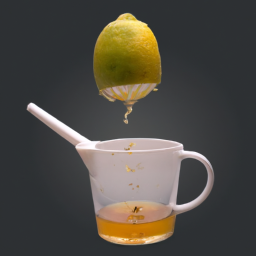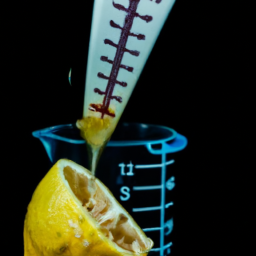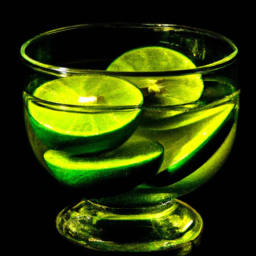I love adding a touch of fresh lemon juice to my dishes and drinks. But I’ve always questioned, how much juice does a single lemon actually produce? Fueled by curiosity as a novice chef, I set out on a mission of investigation and trial to uncover the truth.
Turns out, there are several factors that can affect lemon juice yield, such as the ripeness of the fruit, the juicing method, and even the variety of lemon.
In this article, I’ll share my findings on the average amount of juice you can get from one lemon, as well as tips and techniques for maximizing your lemon juice yield. Plus, we’ll explore the history, nutrition, and fun facts about lemons along the way.
So, let’s get juicing!
Key Takeaways
- The yield of lemon juice can be affected by various factors such as ripeness, juicing method, variety, and acidity levels.
- Efficiency of juicing equipment plays a crucial role in extracting maximum juice, with electric juicers being more efficient.
- Tools and techniques such as citrus juicers, reamers, forks, citrus presses/squeezers, and rolling/microwaving lemons can be used to maximize lemon juice yield.
- Lemon juice is a versatile ingredient that can be used in various ways, including freezing or storing it, incorporating it into lemonade, dressings, marinades, cocktails, and desserts, and using it for cleaning and skincare.
Factors Affecting Lemon Juice Yield
You’ll be surprised at how much juice you can get from one lemon if you give it a good squeeze and don’t let any of it go to waste! However, the amount of juice you can extract from a lemon depends on a few factors.
One of these factors is the acidity levels of the lemon. The more acidic the lemon, the more juice it will yield. So, if you want to get the most juice out of your lemon, try to choose the ones that are the most acidic.
Another factor that affects lemon juice yield is the efficiency of your juicing equipment. If you’re using a manual juicer or your hands to squeeze the lemon, you may not be able to extract all the juice from the fruit. On the other hand, if you’re using an electric juicer, you’ll be able to extract more juice from the lemon. So, if you’re serious about getting the most juice out of your lemons, you may want to invest in a good juicing machine.
With that in mind, let’s move on to the next section and find out the average lemon juice yield.
Average Lemon Juice Yield
On average, a lemon yields a fair amount of tasty juice because lemons are naturally juicy fruits. However, the amount of juice you can extract from a lemon depends on several factors, including its freshness and the technique used to extract the juice. A fresh, juicy lemon will yield more juice than a dry, old one. Also, how you extract the juice matters. Squeezing a lemon by hand may not yield as much juice as using a juicer or a reamer.
When it comes to juice extraction, there are several tools and techniques you can use to get the most juice out of your lemons. In the next section, I’ll discuss the different tools and techniques for juicing lemons. By using the right tools and techniques, you can maximize the amount of juice you get from each lemon. This can be especially helpful when you need a large amount of lemon juice for a recipe or for preserving lemons.
Tools and Techniques for Juicing Lemons
To maximize your lemon juice yield, try using different tools and techniques such as a citrus juicer, reamer, or even a fork to extract every last drop of juice. Here are some tips to get the most out of your lemons:
-
Citrus Juicers: These machines are specifically designed for juicing lemons and other citrus fruits. They come in different sizes and shapes, but they all work by pressing the fruit against a reamer or cone-shaped juicing head. The juice flows down into a container or pitcher while the pulp and seeds are trapped in another compartment. Citrus juicers are efficient, easy to use, and produce a lot of juice in a short amount of time.
-
Reamers: Reamers are handheld tools that have a conical tip and a handle. They are perfect for juicing one or two lemons at a time and are easy to clean. To use a reamer, cut the lemon in half and hold it over a bowl or cup. Place the tip of the reamer into the flesh of the lemon and twist it back and forth while applying pressure. The juice will flow out of the holes in the tip and into the container below.
-
Forks: If you don’t have a citrus juicer or a reamer, you can still extract lemon juice using a fork. Cut the lemon in half and hold it over a bowl or cup. Insert the tines of the fork into the flesh of the lemon and twist it back and forth while squeezing the lemon with your other hand. The juice will come out of the holes made by the fork and into the container below.
-
Lemon preservation: To get the most juice out of your lemons, make sure they’re fresh and at room temperature. Cold lemons are harder to juice and yield less juice than warm lemons. If you have more lemons than you need, you can preserve them by squeezing the juice into ice cube trays and freezing them. Once frozen, store the lemon cubes in a plastic bag or container in the freezer for up to six months.
When it comes to juicing lemons, the right tools and techniques can make all the difference. Now that you know how to juice a lemon using different methods, let’s move on to some tips for getting the most juice out of your lemons.
Tips for Getting the Most Juice Out of Your Lemons
If you want to maximize your lemon juice yield, there are a few simple tips to keep in mind. These juicing hacks can help you get the most out of your lemons, ensuring that you’re not wasting any precious juice. One of the easiest tips is to roll the lemon on a hard surface before juicing. This will help to break down the internal membranes and release more juice. You can also try microwaving the lemon for 10-15 seconds before juicing, as this can help to soften the lemon and make it easier to extract juice.
Another tip for getting the most juice out of your lemons is to use a citrus press or squeezer. These tools are designed to extract every last drop of juice, and can be a great investment if you’re a regular lemon juicer. Additionally, if you want to preserve your lemons for later use, you can freeze the juice in ice cube trays or store the whole lemon in the fridge. These preservation techniques can help you to make the most of your lemons, even if you don’t need to use them right away. With these tips in mind, you can be sure that you’re getting the most out of your lemons and minimizing waste.
When it comes to lemons, there are plenty of other ways to use them beyond just juicing. From adding zest to baked goods to infusing water with lemon slices, there are countless ways to incorporate the bright, tangy flavor of lemons into your cooking and drinking.
Other Ways to Use Lemons
Discover the endless possibilities of incorporating lemons into your culinary adventures – they’re like the versatile Swiss Army knives of the fruit world, adding a zesty pop to everything from dressings and marinades to cocktails and desserts.
But did you know that lemons can also be used for cleaning? That’s right, lemon-based cleaning products are a popular and effective way to clean everything from countertops to cutting boards.
If you’re looking to expand your lemon repertoire beyond just cooking, try incorporating them into your cleaning routine or trying out some lemon-themed recipes. Here are a few ideas to get you started:
- Lemon and herb roasted chicken – this dish is a classic for a reason, the tangy citrus pairs perfectly with savory herbs.
- Lemon garlic shrimp scampi – a quick and easy weeknight dinner that’s bursting with flavor.
- Lemon and honey face mask – the natural antibacterial properties of lemon make it a great addition to your skincare routine.
- Lemon and vinegar cleaning spray – mix equal parts lemon juice and vinegar for a natural and effective cleaning solution.
Now that you know some other ways to use lemons beyond just cooking, let’s dive into the nutritional benefits of this citrus powerhouse.
Lemon Nutrition Facts
When it comes to nutrition, lemons pack a powerful punch! I’m excited to learn about the high vitamin C content of this citrus fruit. But that’s not all – I’m also curious to explore the other vitamins and minerals that lemons provide, and their potential health benefits.
Let’s dive in and discover what makes lemons such a nutritional powerhouse!
Vitamin C content
Did you know that one lemon contains about 30-40 milligrams of Vitamin C, making it a great source of this essential nutrient?
Vitamin C is an important antioxidant that helps protect the body from damage by free radicals, which can contribute to chronic diseases such as cancer and heart disease. In addition to its antioxidant properties, Vitamin C also plays a critical role in the immune system, helping to promote the production of white blood cells that fight off infections and viruses.
If you’re looking to incorporate more Vitamin C into your diet, lemonade is a refreshing and delicious way to do so. Not only does it provide a boost of Vitamin C, but it’s also a great way to stay hydrated during the warmer months.
There are countless lemonade recipes out there, from classic versions that combine lemon juice with sugar and water to more creative variations that incorporate herbs, spices, and other fruits. Whether you prefer your lemonade sweet or tart, there’s a recipe out there for you.
When it comes to overall nutrition, lemons are also a good source of other vitamins and minerals such as potassium, folate, and Vitamin B6. Incorporating lemons into your diet can provide a range of health benefits, from supporting the immune system to promoting healthy digestion.
So next time you’re at the grocery store, consider adding a few lemons to your cart and experimenting with some new lemon-based recipes.
Other vitamins and minerals
As we’ve learned earlier, lemons are an excellent source of vitamin C, which plays a crucial role in supporting our immune system. But did you know that lemons also contain other essential vitamins and minerals?
These include potassium, calcium, and vitamin B6, all of which are necessary for maintaining optimal health. Incorporating lemons into your diet is a great way to supplement your vitamin and mineral intake.
You can use them in a variety of recipes, from salad dressings to marinades and even desserts. In addition, lemon supplements are available in the form of capsules or powders, making it easy to get your daily dose of lemon nutrients.
So next time you’re in the kitchen, try adding a squeeze of fresh lemon juice to your dish and reap the benefits of these powerful citrus fruits. Consuming lemons has numerous health benefits, from improving digestion to reducing inflammation.
Let’s explore these benefits in more detail in the next section.
Health benefits of consuming lemons
Lemons are a fantastic addition to any diet, offering a wide range of health benefits that can improve digestion, reduce inflammation, and support overall well-being. The high vitamin C content in lemons can help boost the immune system, while the citric acid can improve digestion and prevent kidney stones.
Additionally, lemons contain flavonoids, which are antioxidants that can protect the body against cellular damage and reduce the risk of chronic diseases.
Incorporating lemons into your diet can be easy and delicious. Lemon water is a refreshing way to start the day and can aid in digestion. Adding lemon juice to salad dressings or marinades can enhance the flavor and nutritional value. Lemon zest can be used to add a zing to baked goods or as a garnish for savory dishes. There are endless recipes that incorporate lemons, making it easy to reap the health benefits while enjoying delicious meals.
Now, let’s explore the different varieties of lemons available.
Lemon Varieties
There’s a wide range of lemon varieties available, each with its unique flavor profile. When it comes to lemon varieties, there are generally two categories: tart and sweet. Tart lemons, such as the Eureka and Lisbon varieties, have a bright, acidic flavor that’s perfect for cooking and baking. Sweet lemons, such as the Meyer variety, have a milder, sweeter flavor that works well in desserts and drinks.
In addition to tart versus sweet, there are also heirloom versus hybrid varieties. Heirloom lemons, such as the Ponderosa and Villafranca varieties, are older and more traditional varieties, often with distinct regional flavors. Hybrid lemons, such as the Femminello and Primofiori varieties, are newer varieties created by crossbreeding different lemon varieties. Another factor to consider is lemon cultivation, whether it’s organic versus conventional or homegrown versus commercial. Each of these factors can affect the flavor and quality of the lemons.
Now that we’ve explored the different types of lemon varieties, let’s dive into the history of this versatile fruit.
Lemon History
It’s surprising to know that lemons weren’t always popular in cooking and were once considered a luxury item. In fact, lemons were introduced to Europe by Arab traders in the 1st century AD. Lemons were primarily grown as ornamental plants rather than for consumption until they were cultivated in Europe in the 16th century. It was only when the lemon trade increased in the 18th century that lemons became more widely available and affordable for the general population.
Lemons also have cultural significance in many countries. For example, in Hinduism, lemons are often used in religious ceremonies and are believed to ward off evil spirits. In some Latin American countries, lemons are used in traditional medicine to treat a variety of ailments. The lemon has also become a symbol of Italy, where it is used in everything from limoncello to pasta dishes.
It’s fascinating to see how such a small fruit has played such a big role in history and culture. Speaking of lemons, did you know that the juice from one lemon typically yields about 2-3 tablespoons?
Let’s move on to some more fun facts about this versatile fruit.
Lemon Fun Facts
Now that we know a little bit about the history of lemons, let’s move on to some fun facts! Did you know that lemons were once used as a status symbol in ancient Rome? Wealthy women would use the juice to lighten their hair, while their less fortunate counterparts would simply have to settle for darker locks. Additionally, lemons have been known to be an effective natural cleaner, thanks to their acidity. You can use a mixture of lemon juice and water to clean surfaces like cutting boards and countertops.
Speaking of lemon juice, have you ever wondered how much juice you can get from one lemon? On average, a single lemon can produce about 2-3 tablespoons of juice. Of course, this can vary depending on the size and ripeness of the lemon. But once you have that juice, there are so many delicious things you can make with it! Lemon is a popular ingredient in both sweet and savory dishes, from lemon bars and lemon meringue pie to lemon chicken and lemon pasta. And if you’re looking for a refreshing drink that isn’t your average lemonade, try adding some lemon juice to sparkling water for a fizzy, citrusy treat.
Frequently Asked Questions
What is the best time of year to buy and juice lemons?
The best time of year to buy and juice lemons is in the winter months when they are in season. Proper juicing techniques involve rolling the lemon before juicing and using a citrus juicer. Best storage methods involve keeping them refrigerated.
How long does lemon juice stay fresh?
Lemon juice shelf life can vary based on storage method. Freshly squeezed juice can last up to 2-3 days in the fridge, while bottled lemon juice can last up to a year if refrigerated after opening. Storing lemon juice in an airtight container can help prolong its freshness.
Can you substitute bottled lemon juice for fresh lemon juice in recipes?
Substituting bottled lemon juice for fresh may save time, but it lacks the benefits of fresh lemon juice. Fresh lemon juice adds zest and flavor to recipes. Don’t compromise taste for convenience.
Are there any types of juicers that work better for juicing lemons?
When it comes to juicing lemons, Citrus Press Juicers and Manual Squeezers are the most effective options. While Electric Juicers may be faster, they can also be less efficient and produce more pulp.
How does the acidity of lemons affect the amount of juice they produce?
The acidity of lemons can impact the amount of juice they produce. To get the most juice, try rolling the lemon on a hard surface before juicing or microwaving it for a few seconds. Squeezing by hand or using a citrus juicer are both effective techniques.
Conclusion
So, how much juice do you get from one lemon? The answer is not that simple as it depends on various factors. However, on average, a lemon yields around 2-3 tablespoons of juice.
But with the right tools and techniques, you can get even more juice out of your lemons. To get the most juice out of your lemons, try using a citrus juicer or reaming the lemon with a fork before squeezing. Roll the lemon on a hard surface before juicing to break down the membranes inside, and consider microwaving the lemon for a few seconds to warm it up. These tips can help you extract every last drop of juice from your lemons.
Lemons are not only a great source of juice but also have many other uses, from cleaning to cooking. They’re a versatile fruit with a rich history, having been used for centuries in various cultures. So, next time you use a lemon, remember its many benefits and try to get the most juice out of it!
Ilana has been a vegan for over 10 years. She originally made the switch for health reasons, but soon found herself becoming more and more passionate about the ethical and environmental implications of a vegan lifestyle. Ilana is the author of The Graceful Kitchen, a blog all about veganism. She loves to cook up delicious and nutritious vegan meals, and share her recipes with others who are interested in leading a cruelty-free life. Ilana is also a strong advocate for using whole foods as the foundation of a healthy diet, and believes that going vegan is one of the best ways to achieve this.










